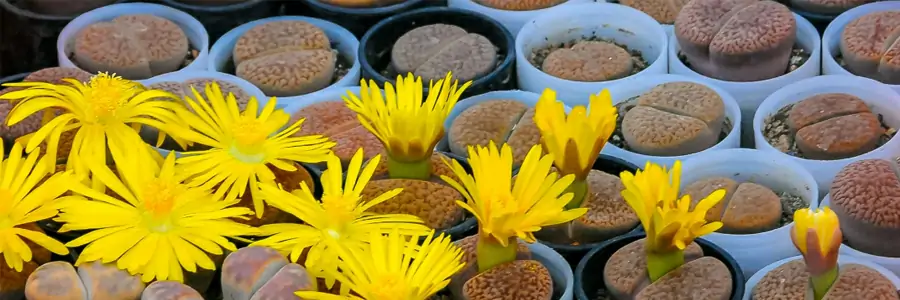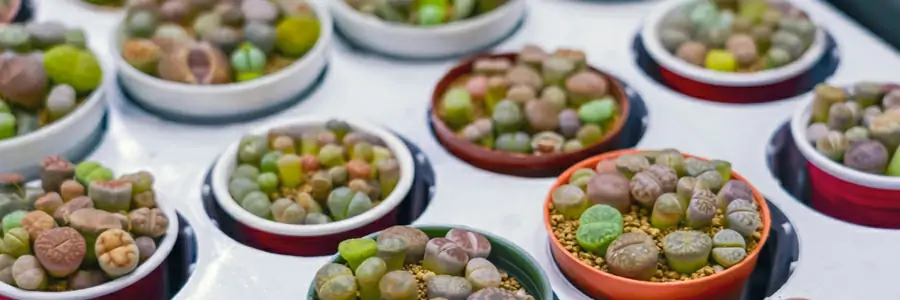Lithops
Taxonomic Classification
Lithops belongs to the family Aizoaceae. The genus name “Lithops” is derived from the Greek words “lithos” meaning “stone” and “opsis” meaning “appearance”, which aptly describes their stone – like appearance. This genus is composed of about 40 recognized species of succulent plants, native to southern Africa, particularly in regions with arid and semi – arid climates.

Morphological Characteristics
1.Body Structure
Lithops plants are small and compact, typically growing close to the ground. Each plant generally consists of two thick, fleshy leaves that are fused together at the base, forming a structure that resembles a small pebble or stone. The leaves are highly succulent, storing water to help the plant survive in its dry habitat. The space between the two leaves is where the new leaves and flowers emerge.
2.Leaf Features
The leaves of Lithops have a unique texture and coloration that mimic the surrounding rocks and gravel in their natural environment. This is an evolutionary adaptation known as mimicry, which helps them avoid being eaten by herbivores. The surface of the leaves can be smooth or have various patterns, dots, or lines, and the colors range from shades of gray, brown, green, to even reddish – brown, depending on the species and the local soil and light conditions. Some Lithops have translucent “windows” on the tops of their leaves. These windows allow sunlight to penetrate deep into the plant’s interior, where photosynthesis can occur even when the plant is mostly buried under sand or gravel.
3.Flowering Characteristics
Lithops produce daisy – like flowers that emerge from the fissure between the two leaves. The flowers are relatively large compared to the size of the plant and can be white, yellow, or in some cases, a combination of these colors. The flowers usually open in the afternoon and close at night. They are pollinated by insects, and after successful pollination, the plant produces a capsule containing numerous tiny seeds.

Common Varieties
1.Lithops aucampiae
This is one of the most well – known Lithops species. It has a variety of forms, but generally, the plants have smooth, rounded bodies with a range of colors from light gray to brown. The flowers are large and yellow, adding a bright contrast to the stone – like appearance of the plant. Some forms of Lithops aucampiae have interesting patterns on their leaves, making them highly sought – after by collectors.
2.Lithops lesliei
Lithops lesliei typically has a more elongated body shape compared to some other species. The leaves can be greenish – gray with dark markings, which help it blend in with the rocky soil in its native habitat. It produces white flowers that are quite showy against the plant’s subtle – colored body. This species is known for its relatively easy cultivation and is a popular choice for beginners.
3.Lithops hookeri
Lithops hookeri is characterized by its often flattened, disc – shaped bodies. The color of the leaves can vary from light brown to a more reddish – brown, and they may have small dots or lines on the surface. The flowers are yellow and add a pop of color to the plant. This species is native to specific regions in South Africa and is prized for its unique shape and coloration.
4.Lithops julii
Lithops julii has distinctively patterned leaves. The surface of the leaves may have a network of dark lines or dots, creating an intricate pattern. The bodies are usually small and compact, and the color can range from gray to brown. It produces yellow flowers, and its unique appearance makes it a favorite among Lithops enthusiasts.
5.Lithops pseudotruncatella
This species has a more angular or flattened – top appearance compared to some other Lithops. The leaves can be grayish – green with a rough texture and may have small, raised dots. It produces white flowers. Lithops pseudotruncatella is known for its ability to adapt to a relatively wide range of growing conditions, making it a suitable choice for both indoor and outdoor cultivation in appropriate climates.
